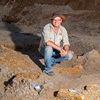Tag: Stephen F. Poropat

Stephen has worked at Uppsala University (Sweden) since October 2011, in conjunction with the Australian Age of Dinosaurs Natural History Museum (Winton, Queensland, Australia). His recent research has focused mostly on sauropod dinosaurs, with the primary interest being the phylogenetic relationships and palaeobiogeographic implications of Australian Cretaceous sauropods. Stephen has also worked on Chinese sauropod and theropod specimens held in the Palaeontological Collections at the Museum of Evolution of Uppsala University. Stephen completed his PhD in May 2011 at Monash University (Melbourne, Australia) under the supervision of Jeffrey Stilwell and Michael Hall, working on the biostratigraphy and palaeoenvironmental implications of late Early Cretaceous non-marine ostracod faunas from the South Atlantic Ocean. You can read more about his work at: http://www.stephenporopat.weebly.com
Contact Details:
Dr. Stephen F. Poropat, Palaeobiology Programme, Uppsala University, Uppsala, Sweden, and Australian Age of Dinosaurs Natural History Museum, Winton, Queensland, Australia.